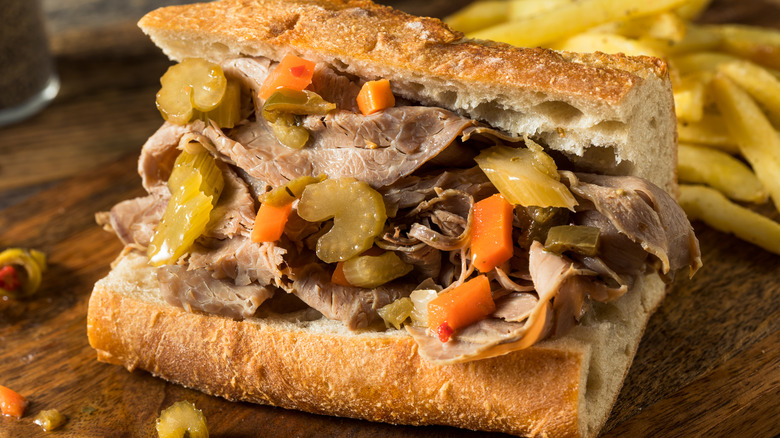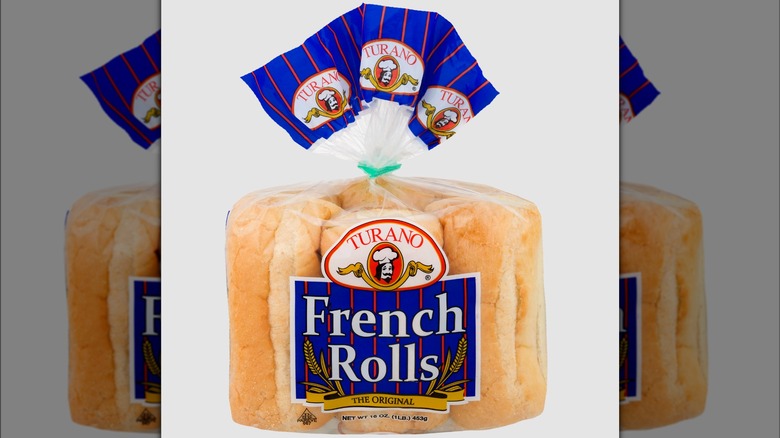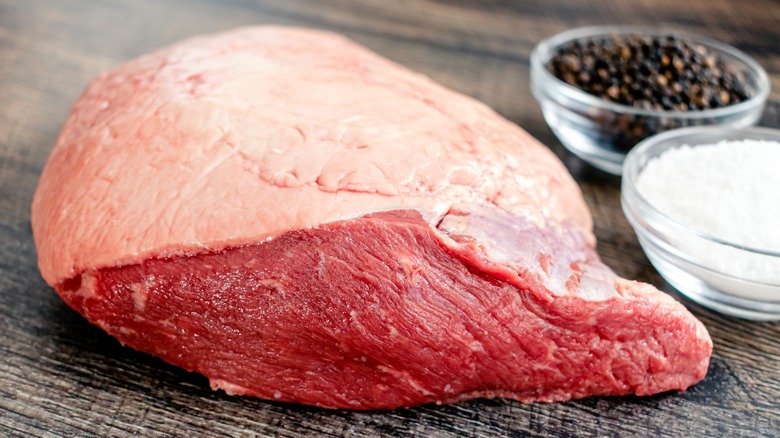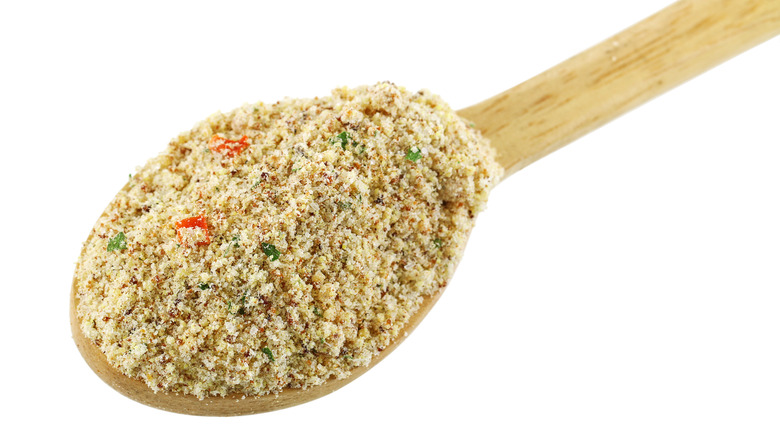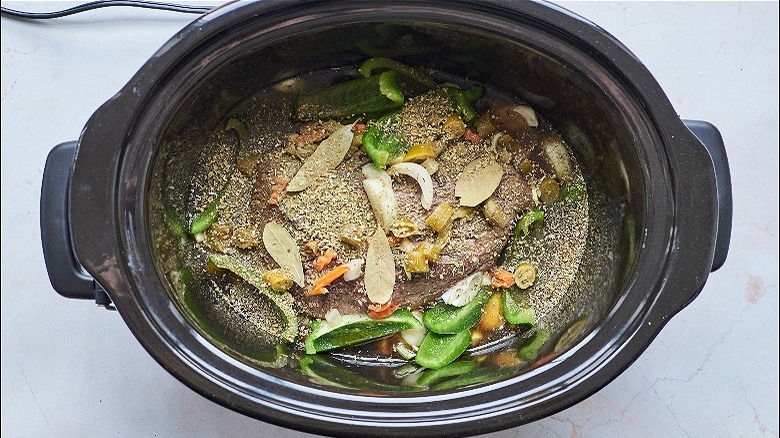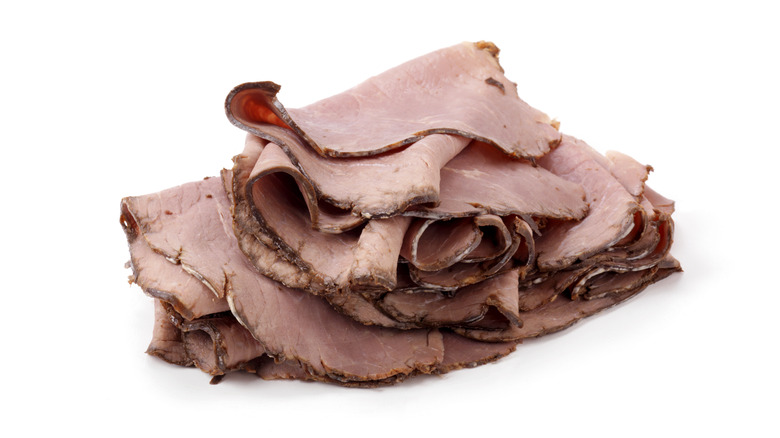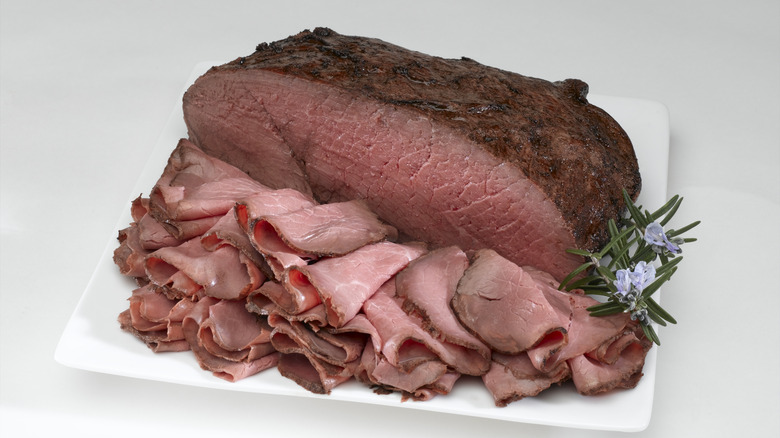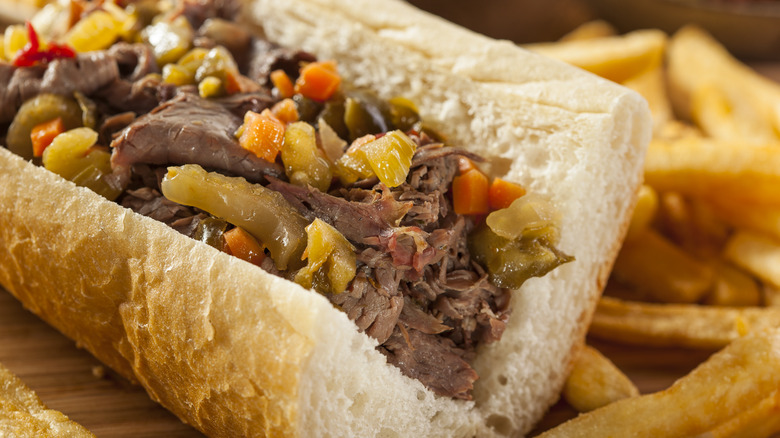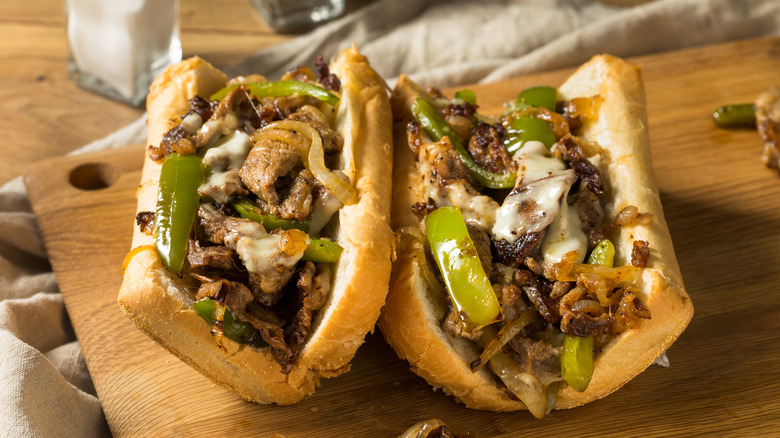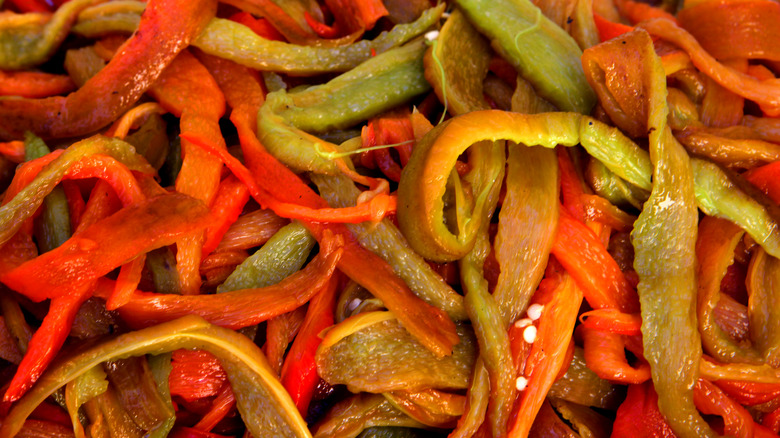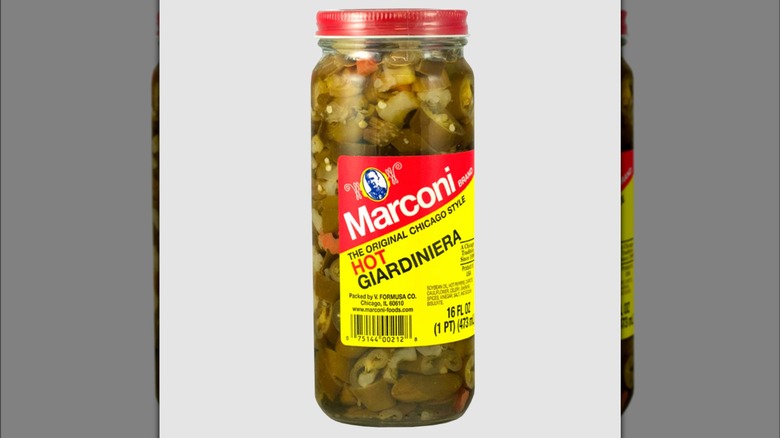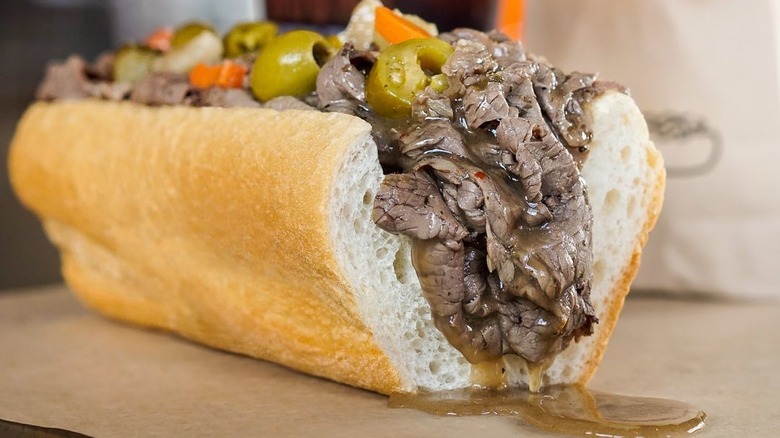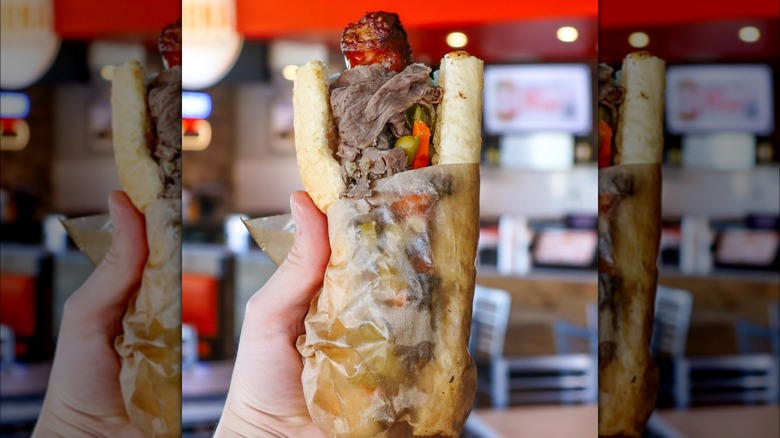12 Tips You Need To Make The Ultimate Italian Beef Sandwich
When "The Bear" debuted in 2022, it introduced millions of Americans to Chicago's favorite hometown sandwich: the Italian beef. It made sense that the popularity of the show caused a temporary dramatic spike in popularity for the homely but delicious sandwich. If your love for the Hulu hit (or just a hankering for delicious food) is giving you an Italian beef craving, consider making the dish at home. Although some beef houses are chains with locations outside of Chicago, in much of the country, it's difficult to find places that serve this Windy City delicacy.
The tips in this article will lead you on the way to recreating the iconic sandwich with impossibly-thin slices of roast beef soaked in au jus, exactly like you'd find from any Chicago beef house. We'll warn you that it's a bit of a project, but the results are well worth your time (and the mess).
1. Choose the proper bread
Although Italian beef is a reference to the sandwich's meaty filling, this dish is nothing without high-quality bread. The beef should be dripping with au jus, and many people like to order the sandwich pre-dunked — it takes a sturdy roll to stand up to all that liquid without falling apart. That's why the vast majority of Italian beef places in Chicago use Turano or Gonnella rolls.
Some classic beef joints in Chicago like Johnnie's Italian Beef get Turano to custom-bake bread for them, but the packaged grocery store-available rolls from these bakeries do a fine job. Unlike Philadelphia hoagie rolls or the French bread used for po-boys, Chicago-style sandwich rolls are dense and chewy rather than light and flaky. This gives them the structural integrity they need to contain all of the delicious meat juices you want in an Italian beef.
If you live far away from Chicago, you might not be able to find these specific brands of rolls in your local grocery store. You can buy Turano rolls online, but if you're okay with making substitutions, whatever hoagie or sub rolls you can find in your supermarket is good in a pinch. You should be prepared for your sandwich to fall apart if you go this route, but that's not the end of the world — nobody expects eating an Italian beef to be a mess-free process.
2. Select a cut of sirloin or round
When selecting the cut of meat for Italian beef, you have options. Different places use various cuts of beef, but there seems to be one constant: it should come from the back half of the animal — either the sirloin or the hind leg. Al's, one of Chicago's most historic Italian beef businesses, uses top sirloin butt, a cut from the top rear of the sirloin primal directly in front of the animal's rear leg. Various cuts of top sirloin make great beef sandwiches, including sirloin cap, AKA picanha steak.
Other recipes call for top or bottom round, which both come from the rump/hind leg area of the cow. Top and bottom round are both leaner and chewier than sirloin, with bottom round (preferred by several notable spots including Portillo's) being the toughest of the bunch. One of the great things about Italian beef is that it lets you transform tough, cheap cuts of meat into something tender and delicious. After you slow-cook the beef and slice it paper-thin, even bottom round develops a melt-in-your-mouth texture.
The beef shops roast huge joints of meat because they're serving hundreds of sandwiches a day. If you're cooking at home, a small 2-4 pound roast should be more than sufficient.
3. The meat needs to be heavily seasoned, but the specifics are up to you
One thing that most of the famous Italian beef shops have in common is that they shower their meat in a generous application of secret dried seasonings. And we do mean secret — the owners of Al's, Johnnie's, and Tony's (to name some of the city's finest shops) all refuse to name even a single spice they use in their seasoning blends.
From what we can tell, there is a decent amount of variance between the recipes the shops use. Al's seasoning mix is bright red and appears to contain paprika, mustard seed, pepper, bay leaves, and many other components. Johnnie's and Tony's spice blends look much heavier on dried herbs like oregano. Home recipes can include umami boosters like beef bouillon, MSG, or soy sauce as well. Onion powder, garlic powder, Italian herbs, black pepper, and a small amount of something spicy like cayenne or chili flake are all welcome additions.
Whatever herbs and spices you choose, be generous with them. You're roasting a big piece of meat here, and you need enough seasoning to flavor both the meat and the juices you'll later use to soak the sandwich. It can help to massage or press your spice rub into the exterior of the meat before roasting — this ensures that the flavor will stick to the beef and that you'll be able to taste the spices once the meat is cooked.
4. Cook the beef with a lot of liquid
The term "roast beef" conjures up images of a dry cooking method, but the technique used by beef shops is actually sort of halfway between roasting and braising. Al's roasts its beef in big commercial deck ovens in pans about halfway full of water. Johnnie's skips the oven entirely, cooking the meat in a tilt skillet instead (a tilt skillet is basically bathtub-sized frying pan that comes with its own heating element). You can even break out the crock pot and go with a slow-cooker Italian beef recipe.
The ample amount of liquid serves two purposes. First, it may help prevent the beef from drying out during its time in the oven. Second, and perhaps most important, is that the liquid forms the base of the au jus or gravy that is the backbone of a great Italian beef sandwich. All of the juices from the beef and the flavors from the seasoning mix infuse the water in the pan, turning it into liquid gold.
The beef shops are cooking enormous hunks of meat that leech a ton of flavor into the water. If you try the same technique at home and find the flavor of your jus to be a bit lacking, sub out the water for a rich beef stock. Beef bouillon cubes will work in a pinch too.
5. Slice the beef as thinly as possible
Since the meat in Italian beef sandwiches traditionally comes from tough parts of the cow, slow-cooking the beef in liquid helps to tenderize it. However, this technique isn't enough on its own. If you've ever had a real Italian beef, you know the meat is so soft that you barely need to chew it. To ensure this buttery texture, the beef should be sliced super-thin — the ideal width is literally the same as a piece of paper.
If you try to cut the meat when it's fresh out of the oven, prepare for disappointment. Freshly-cooked beef is far too soft and will just end up shredding. You'll end up with a pulled beef sandwich, which, while delicious, is not traditional Italian beef. Chicago beef houses chill their meat overnight to firm it up before trimming the fat and gristle and running it through a deli slicer for skinny, uniform cuts.
We imagine that most of you reading this probably don't have deli slicers at home. If this is your situation, you'll have to make do with your sharpest carving knife. You should be able to cut nice, thin shavings from a chilled hunk of beef by hand — they won't be deli slicer-thin, but they'll get the job done. The process may take longer than you would prefer, but it's worth the wait.
6. If you can't get your beef thin enough, deli-sliced roast beef is a good substitute
We're not going to sugarcoat it: slicing the meat for Italian beef sandwiches with a knife is a pain. It takes forever, and even if you've got expert knife technique, you'll never match the mechanical precision of a deli slicer. If you'd rather not bother, you can skip the whole "roasting and slicing your own meat" step entirely. It's not even really cheating — although the famous destination spots in Chicago roast their own beef, most of the regular neighborhood beef joints buy pre-sliced beef in gravy. All the restaurant has to do is reheat and serve.
If you'd like to go this route, there are multiple brands available online, including Vienna Beef and Portillo's — in fact, you can get beef, gravy, rolls, and giardiniera all delivered to your door for assembly at home. You may want your beef sandwiches to feel a little more homemade than that, however, and for you, there's a middle path: roast beef from your grocery store's deli counter. This is an especially good option if your local supermarket roasts its own beef. Just order the meat sliced extra extra-thin, make homemade gravy/jus, and reheat the beef until it's hot, tender, and succulent. Add the same seasonings to your gravy that you would if you were roasting the beef yourself: beef stock/bouillon, dried herbs, chili flakes, garlic powder, and the other usual suspects.
7. Reheat the beef in gravy — but don't over do it
Whether or not you end up roasting your own beef, once it's sliced, it needs to be reheated in the gravy/au jus before it goes into sandwiches. There's some disagreement about how much you should cook the beef before it's sliced. Some shops take it all the way to well-done during the initial roast, but other experts, including "The Bear" culinary producer Courtney Storer, recommend starting with rare or medium-rare beef and finishing the cooking process in the jus.
No matter how well-done your sliced beef is on its way into its jus bath, you should be careful not to overcook it during this phase of the process. The goal is to just get it hot enough to loosen up a bit, not to make boiled beef. Heat up your jus in a pan just until it's steaming — not boiling. Add the beef and cook until it's hot. You definitely don't want to take it up past around 150-160 degrees Fahrenheit — it will become tough if it gets any hotter than that.
8. Don't add cheese
It would make some intuitive sense to put cheese on an Italian beef — the combo tastes great together. America's other famous sliced beef sandwich served on a long roll, the Philly cheesesteak, has cheese right there in the name. And yet, the traditional Italian beef sandwich build contains no melty additions. Sure, penty of beef shops will sell you a sandwich with cheese — the most common options are mozzarella or provolone. Portillo's even lets you put cheese sauce on your beef sandwich, which sounds like it would be an intriguing hybrid between Italian beef and a Cheez Whiz cheesesteak. But though some Chicagoans acknowledge that cheesy beef sandwiches are delicious, there is a general agreement that adding those slices negates its authenticity.
The point of an Italian beef sandwich is to celebrate the beautiful roast beef and the accompanying savory gravy. Adding too many other components simply covers up the meaty flavor you've worked so hard to create. While what you do in the privacy of your own home is up to you, if your goal is to create the ultimate Italian beef sandwich, leave cheese out of it.
9. Your sweet peppers need to be soft
Bell peppers are a natural fit in Italian beef — their vegetal flavor helps cut through the fatty, savory taste of the meat (without competing with it like cheese would). When you order the sandwich, you have the option of choosing "sweet," "hot," or both. First, we'll deal with "sweet," which refers to sweet peppers (most often, they're green bell peppers). The key to making sweet peppers for Italian beef sandwiches is that they need to be soft. You don't want the crunchy bitterness of a raw green pepper disturbing the delicate equilibrium of your sandwich. You can achieve this in a few different ways.
Perhaps the easiest is to simply add the peppers to the beef cooking liquid while the meat is in the oven. They'll get meltingly tender and pick up a lot of the flavor of the beef. This method is great, but if you want your peppers to offer a bit more taste contrast to the meat, you'll want to cook them separately. Alternatively, simply sauté sliced bell peppers in a skillet until they're super soft.
10. Enlist giardiniera for heat
Now we come to the "hot" side of the equation: giardiniera. This is a mix of pickled vegetables that originated in Italy. Traditional giardiniera is made with big chunks of vegetable pickled in vinegar and is often served as part of an antipasto platter. The kind served in Chicago beef shops is different from the original in a few ways. First off, the vegetables are cut much smaller, which makes it easier to use this giardiniera as a sandwich topper (no big chunks of cauliflower to struggle through). Secondly, Chicago giardiniera usually contains hot peppers or chili flakes. This gives it a spicy bite that's the perfect counterpoint to the beef. Finally, the giardiniera at Italian beef shops is typically packed in oil instead of vinegar (sometimes there's a little vinegar in the mix).
Chicago-style giardiniera is easy to find online. Portillo's uses Marconi, and Vienna Beef makes a good one too. It's also simple to prepare a giardiniera recipe at home. If you want to make it more like the stuff served in beef houses, dice the veggies into smaller pieces and strain off the vinegar once they are marinated, replacing it with oil.
11. Choose your desired moisture level
You've made every component and it's finally time to assemble your sandwich. You now have a very important decision in front of you: How wet do you want your Italian beef to be? Different beef houses use different terminology to name the various stages of sandwich moisture, but the concept is always the same. At one end of the scale is a dry sandwich in which the meat has been thoroughly drained of juice. At the other end is a dipped or "baptized" sandwich, which has been totally soaked, bread and all, in the gravy. In the middle you can choose options like splashing extra gravy on your meat (but not dipping) or just dipping the ends of the sandwich in jus, leaving most of the bread somewhat dry. You can even order the gravy on the side and eat your Italian beef like a French dip.
At home, you can precisely calibrate how much juice you want your sandwich to contain. While preferences are personal, we would dissuade you from making yourself a dry sandwich. Much of the flavor of Italian beef lives in the gravy, and you want a decent amount on your sandwich. The bread can also get a little dry, and it's much more delicious when it's sopping with meat juices. When you're at home, there are no strangers who can see the mess you're making when you eat a fully-dipped Italian beef, so why not go wild?
12. Add a sausage to make a combo
If a filling of perfectly-roasted beef slicked with gravy still isn't enough to satisfy your carnivorous cravings, you can double up on the meat in your homemade sandwich without expending too much extra effort. Simply slide a grilled Italian sausage into your sandwich roll then top it with your beef, peppers, and giardiniera to make what people in Chicago simply call a "combo."
As for what sausage to choose, you can't go wrong with whatever Italian sausage links your favorite butcher offers — it's not like the bread where having the local Chicago product makes a big difference. If you want a nice, crispy crust and some smoke flavor, grilling the sausage over charcoal is the best option. However, making all of the components for an Italian beef at home is quite a hassle, so there's no shame in simply pan-frying your links if you want to go the combo route. A combo is an even messier sandwich than a standard Italian beef, so make sure you eat it with the right technique: hunched over so that the juices don't drip on your shirt.
